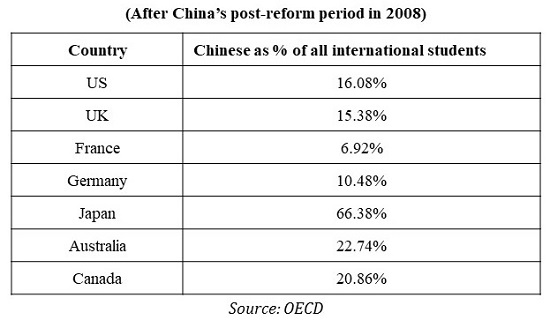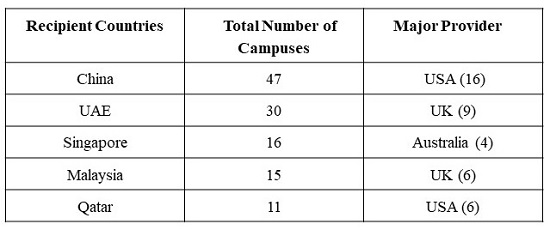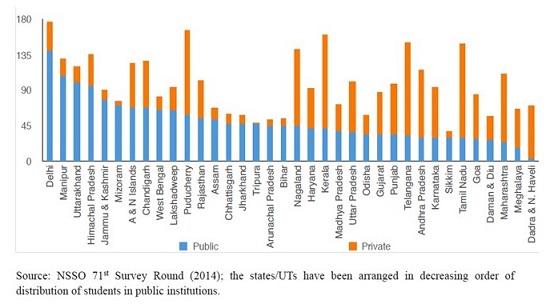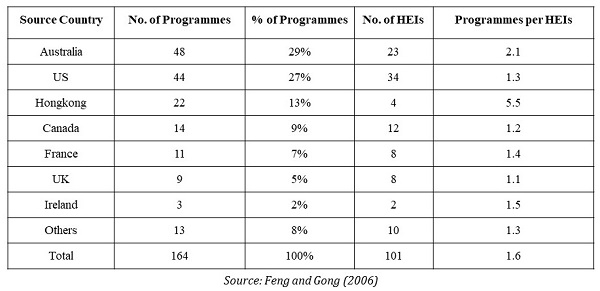Introduction
The third anniversary of the National Education Policy (2020) coincided with Indian Prime Minister, Narendra Modi inaugurating the 'Akhil Bhartiya Shiksha Samagam' at Bharat Mandapam in Delhi on 29th July 2023.[1] The Prime Minister delivered the inaugural address at the event and released the first installment of funds under the PM SHRI Scheme. During the PM’s address, we saw repeated emphasis on the larger dream of developing India into an international education hub. For instances, he said,
"The world is looking at India as a nursery of new possibilities. Many countries are approaching us to open IIT (Indian Institute of Technology) campuses there. Two IIT campuses -- one in Tanzania and one in Abu Dhabi -- are already about to start operations.... Various global universities are also reaching out to us, expressing their interest in setting up campuses in India, ……... .While we have two international campuses of IITs opening in Zanzibar and Abu Dhabi, there are several more nations who are requesting us to open more IIT campuses in their countries”. He also added that, "As India is becoming stronger, the world's interest in India's traditions is also increasing,"[2]
This ambitious goal requires us to think about multiple questions like, what different India has to offer to the world? What are the practical challenges that India would be encountering in the execution? What kind of ‘internationalisation’ are we aiming at? Internationalisation of education is a drive that is happening in multiple countries. Can we adopt the same strategy of a country like America or Qatar and presume that the same strategy would work for India as well? In fact, the project of internationalisation of education can be detached from the geopolitical concerns of each country. Therefore, as a prerequisite, to think about executing the project, what requires us is to have an overview of the geopolitics of higher education. This article attempts the same, and is restricted to the category of ‘higher education.’
Internationalisation of Higher Education
Developing a country as an education hub would technically mean internationalisation of the same. Many believe that higher education by default has an international dimension. But the past few decades have seen an acceleration of this internationalisation in many forms, in different parts of the world. This has to do with the conscious efforts of the governments and people to bring reforms in the sector, an effort that is not unattached from their respective geopolitical concerns. The acceleration involves the rapid expansion in numbers of students studying internationally, increase in institutional partnerships, collaborative research networks, international campuses etc. The role of privatisation or private participation in the field of education played a huge role in this accelerated internationalisation of higher education.[3]
Though one would often tend to associate privatisation with the United States, a good amount of privatisation of higher education in Japan, Taiwan and South Korea in this era cannot be ignored. Understanding the boost that privatisation gave to the process of rapid internationalisation of Higher Educational Institutions (HEIs) in the past few decades, let us understand the different modes in which internationalisation is exercised.
Which are the Popular Modes of Internationalisation of HEIs?
Mode 1: Provider and recipient of the education reside in the same country, and service is provided remotely. In this form, internationalisation is possible only at the level of faculty exchanges, knowledge, or technology transfer.
Mode 2: The recipient of educational services moves to the provider country to access the service. This is a traditional export format. The movement of researchers in connection with long-term projects also falls in this category. China is said to be the major exporter of international students, and the US and UK are their major recipients. The market dependency on China for the US, UK, and Australia is huge.

Mode 3: Providers of education move to the recipient’s country temporarily to deliver service based on terms and conditions agreed upon. This way, many countries can access foreign education even without their students flying abroad or without importing foreign education permanently. This mode is frequently seen in many fly-in faculty programmes delivered for a certain period of time.
Mode 4: In this mode, the provider of education establishes a base in the market of other countries. These institutions are called Foreign Higher Educational Institutions (FHEIs). Terms like ‘import of foreign education’ are used to regard this mode, often in a negative sense. However, the mode is not strange to the world as there are around 333 FHEI campuses worldwide, spread across 39 countries.
List of Largest Importers of FHEIs[4]

List of Largest Providers of FHEIs

Indian universities already have 13 campuses abroad spread across 7 countries - like Manipal and BITS Pilani run their campuses in Dubai, SP Jain School of Global Management in Sydney, as Amity has a campus in London, Singapore etc.[5] This way, it makes India the largest exporter of educational institutions from Asia.
Several IITs have been receiving requests from the Middle-East and South Asian countries. To proceed in that direction, it has been said that IIT Delhi is considering setting up a campus in UAE while IIT Madras is eyeing Nepal, Sri Lanka and Tanzania.[6] Among these, the IIT Delhi and IIT Madras have signed MoU to set up campuses in Abu Dhabi and Tanzania respectively.[7] According to the UGC Chairman M Jagadeesh Kumar, "There is huge potential for setting up campuses in African countries. Thailand, Vietnam and few Gulf countries…there is immense interest and the opportunities are immense too. It is just that we have not had any enabling regulations so far.”[8] Once realised these campuses abroad may be called ‘Indian International Institute of Technology’ (IIIT), as it was recommended by the panel.[9]
Though Indian institutions began to enter the global market the foreign institutions were restricted from entering India. In January 2023, the University Grants Commission (UGC) published draft guidelines permitting Foreign Higher Education Institutions (FHEIs) to establish campuses in India. Later on 9th March, during an event organised by Deakin University, Australian Prime Minister Anthony Albanese announced that Deakin would be the first foreign university to establish a branch in India.[10]
To summarise, internationalising Indian education in its complete sense would mean international students coming to India and Indian institutions, students, and faculties going abroad and making a positive impact. Internationalisation would also involve various other kinds of temporary collaborations between domestic and foreign universities. All these modes collectively make an impact that would reflect the reality of India being a quality destination for education in the world. However, based on the conditions seeking an optimum balance between these different modes of internationalisation would be the key.
India and the Geopolitics of Higher Education
Though the United States continues to dominate the ‘Geopolitics of Education’, in terms of university rankings, we see a considerable rise in Asian universities. However, these Asian universities are mainly from East Asia and the Middle East. For instance, China’s share in the top 100 universities has jumped from 2 to 7 in two years, according to Times Higher Education World University Rankings 2022.[11] According to the same report, South Korea has 3 universities, and Singapore and Japan have 2 each in the top 100 list.
While mentioning the achievements of East Asian Universities, the status of the Middle East as a rising educational hub for the world cannot be ignored. Though King Abdulaziz University of Saudi Arabia couldn’t make it in the top 100, its steeping rise from 190 to 101 in one year sounds astonishing.[12] This is the highest-ranked university in the Middle East region. Backed by heavy investment by the kingdoms, we see an overall rise in the Middle East higher education system. Appreciating Saudi’s performance, Phil Baty, Chief Knowledge Officer, Times Higher Education, said, “Not only has King Abdulaziz University risen dramatically to move within a whisker of the world top 100 to lead the entire Mena region, but other leading institutions have also made strong progress and Saudi Arabia’s overall representation in the World Rankings has increased.”[13]
Overall, the kingdom is ambitious about its Vision 2030 to make it a major destination for higher education. Similarly, many universities in the UAE also see a steeping rise, for instance, the University of Sharjah (jumped to 251-300 from 401-500), and the United Arab Emirates University (jumped to 251-300 from 351-400). Though the parameters of these rankings could be cross-checked, the ongoing renaissance or focus in the Arab World and East Asia to make them a global educational hub cannot be underestimated. In that context, the question is whether India can afford to miss the bus?
The NEP 2020 shares its vision to make India a global educational hub, providing premium education at affordable costs. It also shares India’s civilisational role of being the ‘Vishwa Guru’.[14] So far, the NEP 2020 has remained as a vision and its implementation may go on till 2030.
Regarding its execution, given the different kinds of conditions in India, it will have to adapt to different strategies, unlike China, Singapore, or Gulf countries. The aim is certainly not to satisfy the parameters set by the University Ranking institutions, rather to develop strategies that can overcome India’s limitations to become a desirable global destination for education. However, the global parameters cannot be undermined as they secure the geopolitics of education today. The goal is also not only to attract people by giving quality education at affordable prices. Rather our larger concerns should be, ‘What can India offer differently to the world?’, and ‘What is India’s USP and how to capitalise them?’ To promote the term ‘Vishwa Guru’, India ought to think in this direction.
Let us now bring out a few themes that recur in discussions regarding internationalisation of higher education. These themes are not water-tight compartments; rather' they are to be understood in an interrelated, complementary manner.
- The issue of brain drain
- The quest for autonomy
- The need for diversification
- Need of networking and international collaborations
- Investment and funding
The Issue of Brain Drain
Internationalisation of Indian higher education is also important to prevent brain drain. As per the data given by Minister of State (MoS) in the Ministry of Education, there is a 68% increase in the number of Indian students going abroad for higher studies in the year 2022 (750,365 students in 2022 as against 444,553 in 2021).[15] The decision to bring foreign universities to India could be seen as an effort to prevent this outflow. Many students who travel abroad for education attempt to find a job and settle there, eventually dropping their Indian citizenship, and adopting the citizenship of the destination countries. However, the UGC chairman says that the FHEI guidelines are not intended to reverse the outflow of students from India but to give opportunities to students who want foreign education within India. [16] Nevertheless, the impact the FHEIs can have on brain drain cannot be underestimated. Possibly, this could reduce brain drain not only from India but also from the neighbouring countries of India as well.[17]
The reduction of brain drain cannot be made by the FHEIs alone; rather, by the larger plan of internationalisation itself. Hence, the need to focus on domestic universities is equally important considering the massive gap between the international students coming to India (about 48,000) and the Indian students going abroad (about 8-10 lakhs) per annum. It is true that many students from India who travel abroad take education as an entry point to get a job and citizenship. On the other hand, India may not be able to treat the same with the international students coming to India. Hence, what else would attract them to come here is the key question. India should develop a broader unique research ecosystem of experiential learning where students can expose themselves to compelling ideas that are self-transformative in nature.
The Quest for Autonomy
There are perhaps two models of research universities that we see in dominance: the US led capitalist model and the Soviet (socialist) model. While the Soviet model stands for standardisation and centralisation to a greater extent, the Capitalist model stands for decentralisation and delivering higher education with greater private participation. Even a country like China, which once followed a strict Soviet model with nationally unified teaching plans, and syllabuses, began to undergo a reform in 1978. This reform was introduced with a strong market-based feature to manage and deliver higher education. The reform process that emphasised commercialisation and decentralisation of higher education also constantly attempted to maintain the Chinese character, while imitating the Western model or the US model. This decision has undoubtedly impacted the internationalisation of China’s higher education.
In India also, the influence of the Soviet model in the making of our prominent academic institutions cannot be undermined. It could be argued that India has not consciously adopted the Western model to depart entirely from the Soviet model through major reforms, unlike China. However, in the past few years especially, we have seen a boom in private universities in India (47% rise in four years).[18] The trend indicates how a part of the Indian higher education sector is deviating from the soviet influences in the higher education sector. A data from 2014 shows the following results;

In that scenario, perhaps one could see the quest for more autonomy as a part of the larger tussle between these two models of universities. The present conditions favour universities with more financial, administrative, and academic autonomy. In other words, growth along international standards is directly related to the level of autonomy a university receives at various levels. Hence, autonomy for institutions is important for India to become a global educational hub.[19] However, it shouldn’t be assumed that the governments in countries like the US hardly interfere or bother about their universities in the name of autonomy. The interference, however, differs from the Soviet model, whereas, in the US model, market forces, and mediations of foundations like Ford, Rockefeller Foundation, and other smaller organisations are key influencers in research universities.[20] Hence, the term ‘autonomy’ shouldn’t be taken for granted as it appears in the American university system.
The UGC’s decision to invite foreign universities to set up campuses in India has intensified the debate on autonomy. As per the guidelines, FHEIs would receive more than domestic universities in India. Other than a clause that regulates FHEIs to offer any programme that jeopardises or contradicts the national interest, sovereignty, integrity of India, public order, etc. The guidelines don’t keep many regulations on administrative or financial matters. Giving enough autonomy to foreign institutions while chaining domestic universities would lead to imbalances. Since quality and autonomy are linked, there are chances that situations will erupt where imbalances in opportunities would emerge between foreign and Indian universities.
However, it cannot be undermined that if FHEIs are going to receive more autonomy than domestic universities, it will expose more of the problem in the existing system. Maybe, the domestic universities would then be in a legitimate position to receive better attention from the government pointing to the special treatment given to the foreign. Being that said, the role of government to do the basic regulations on institutions is equally important.
The Need for Diversification
The need for diversification is required at two different levels. One is at the level of various academic disciplines to which international students come to India to join. The other is at the geographical level or the different regions from where these students come to India.
The International students who come to India are minimal in numbers and are limited to areas like STEM (Science Technology, Engineering, and Mathematics) and medicine and not widely spread across disciplines, like humanities, social sciences, natural sciences, etc. Hence, while talking about internationalisation of Indian higher education there is a need for India to go beyond the categories of STEM. For instance, India to become top in areas like Ayurveda is easier than STEM. Likewise, Ayurveda, Yoga, Sanskrit, languages, Indic studies, languages, cultural studies, art, philosophy, etc., should be given special focus to attract international students, as India has a lot to offer in these fields.
The other level of diversification is required in the geographical aspect. At present, the students coming from abroad to India are mainly from a specific bunch of countries. In order to receive students from diverse countries to India, India needs to have differentiated strategies for attracting students from other countries, rather than one strategy for all countries. For instance, while the best students from other countries like Europe may not prefer India, we should not hesitate to attract the students from second tier countries to our institutions. As the standards of India’s HEIs improve, better students from such countries will naturally come. Here is where the foreign policy, embassies for each country, and Edupreneurs who have more autonomy can play a role.
Need of International Collaborations and Networking
International collaborations and international outlook are some of the key parameters in World University Rankings, along with research productivity and citations.[21] The rise of China in the global education sector comes with its decision to have active international collaborations. In the post-reform period that is by 2004 China offered around 700 programmes in collaboration with foreign institutions.[22] The list of its international collaborators of that period is mentioned below.
The year of 2006 was a period after China’s efforts to internationalise higher education. The table given below shows details of its diverse international collaborations:

Though collaborations are important to become a key player in the geopolitics of education and global rankings, it cannot be done mindlessly as there could be risk factors. In any collaboration, India shouldn’t end up being a data provider. India should also be in a strengthened position to offer back before collaborations. Hence, not every collaboration will necessarily contribute in making India an international education hub. On the other hand, how mutual these collaborations will be is the key determining factor.
While networking from university to foreign policy level to bring students from abroad is necessary, networking with industries to offer more scholarship opportunities in India for Indian and foreign students is equally important. On that note, it should be highlighted that just as bringing students from abroad is important, having Residential International Faculty in addition to the Visiting or Guest Faculty from abroad is required. These dedicated faculties with international appeal with great research profile are essential to attract international students. Hence, great attention should be paid to recruiting eminent faculty, including faculties from abroad.
Investment and Infrastructure
The rise of universities in Asia into the global market was made possible primarily because of the heavy funding by their respective countries. The infrastructural requirement to create a research ecosystem comes along with this. For instance, the renaissance of the education sector in the Gulf countries is backed by heavy investment by the kingdom. In Qatar, a foundation established by the royal family, headed by Qatar's current ruler, funds the bills for the branch campuses even of the FHEIs established in Qatar.[23]
It is true that to develop India as a vibrant international educational hub requires more funding and infrastructure. Infrastructure facilities would also include the preparation to cater to security risks, dealing with issues like discrimination, etc., to make India a welcoming destination for education. Even a single case of discrimination against an international student in India can lead to a massive outbreak globally. Unnecessary formalities in the visa regimes, delays in FRO registration, and all other processes make it difficult for international students to apply in Indian universities.
Building physical infrastructure is necessary in every field, and education is not an exception. However, overbuilding infrastructures may not necessarily yield results. In fact, many of the university buildings and campuses in India are bigger in size. To our times, capitalising on sustainable engineering, minimal consumption, simple way of life - if approached creatively, may help to sell an Indian experience to teach ‘less is more’.
In terms of financing, anticipating endless funding from the government might be too much to expect. Former HRD minister Kapil Sibal and academician Pratap Bhanu Mehta, while discussing UGC guidelines on FHEIs argue that the decision favours the rich for specific reasons. Both of them suggest similar ideas to solve the crisis by endlessly funding domestic institutions to bring them to world-class facilities. While Mehta says it requires continual reinvestment, which is not derived from fees alone,[24] Sibal says, “...the government should be committed to financing public universities in a big way...” [25] Providing ongoing, unconditional funding for higher education institutions to a country like India, considering the nature of its economy, people’s priorities, population, etc., is unlikely. This is because India cannot have an absolute Soviet (socialist) model where centralisation and continuous financing by the government remains the dominant characteristic of its higher education system. While the problem they are raising is understandable, the solutions they are suggesting of state endlessly funding come from a soviet model, which is already in crisis. India cannot have a complete Western (capitalist) model of higher education as it neither has a colonial past like the West nor a heavily industrialised economy, or an autocratic political body like contemporary China. Therefore, a balance has to be sought.
References
[1]Shankar Ravi “PM Modi inaugurates Akhil Bharatiya Shiksha Samagam 2023”
https://timesofindia.indiatimes.com/education/news/pm-modi-inaugurates-akhil-bharatiya-shiksha-samagam-2023/articleshow/102229843.cms Times of India. Accessed: July 31, 2023
[2] “World looking at India as nursery of new possibilities: PM Modi”
https://economictimes.indiatimes.com/news/india/world-looking-at-india-as-nursery-of-new-possibilities-pm-modi/articleshow/102227177.cms The Economic Times. Accessed: July 31, 2023
[3]Knight, J (2004) Internationalisation remodelled: definition, approaches and rationales, Journal of Studies in International Education, 8.
[4]International Campuses as of March 2023 https://www.cbert.org/intl-campus C-BERT. Acessed: July 31, 2023.
[5]India’s major recipient is UAE(5 campuses), followed by Uzbekistan and SIngapore (2), and one each in Australia, Mauritius, Nepal and Sri Lanka. https://www.cbert.org/intl-campus C-BERT. Accessed: July 31, 2023.
[6] “Huge potential for setting up Indian campuses in African and Gulf nations, Thailand, Vietnam: UGC'' https://www.onmanorama.com/career-and-campus/top-news/2023/03/17/ugc-says-huge-potential-for-setting-up-indian-campuses-in-african-gulf-nations-thailand-vietnam.html OnManorama. Accessed: July 31, 2023
[7] “IIT Abu Dhabi Soon! IIT Delhi to set up 2nd Global IIT, MoU singed during PM Modi’s UAE Visit” https://www.timesnownews.com/education/iit-abu-dhabi-soon-iit-delhi-to-set-up-2nd-global-iit-mou-signed-during-pm-modis-uae-visit-article-101782997 Timesnow. Accessed: July 31, 2023.
[8]He also added that "IITs are known as institutions of national importance, they function under IIT Council. It has its own rules and regulations under which they can set up their own campuses. Already some IITs are working on that," See in “Indian varsities to set up campuses abroad | African and Gulf countries, Thailand, Vietnam probable locations”https://www.indiatoday.in/education-today/news/story/indian-varsities-to-set-up-campuses-abroad-african-and-gulf-countries-thailand-vietnam-probable-locations-2347666-2023-03-16
India Today. Accessed: July 31, 2023.
[9] “IITs abroad may be called 'Indian International Institute of Technology'”
https://economictimes.indiatimes.com/industry/services/education/iits-abroad-may-be-called-indian-international-institute-of-technology/articleshow/93875441.cms?from=mdr The Economic Times. Accessed: July 31, 2023 .
[10]ANI reports “Deakin University will be the first university to establish an international branch campus in India: Prime Minister Anthony Albanese ”https://www.aninews.in/news/business/ business/deakin-university-will-be-the-first-university-to-establish-an-international-branchcampus-in-india-prime-minister-anthony-albanese20230309162015/ ANI. Accessed: July 31, 2023.
[11]https://theprint.in/india/education/with-131-new-institutions-in-4-years-its-boom-time-for-private-universities-in-india/726908/
[12]Rizvi Anam “Saudi Arabia leaps ahead in World University Rankings 2023”
https://www.thenationalnews.com/uae/education/2022/10/12/saudi-universities-leap-ahead-in-global-rankings/ The National News. Accessed: July 31, 2023.
[13]Rizvi Anam “ Saudi Arabia leaps ahead in World University Rankings 2023”
https://www.msn.com/en-ae/news/national/saudi-arabia-leaps-ahead-in-world-university-rankings-2023/ar-AA12R7xv MSN. Accessed: July 31, 2023
[14]NEP 12.8 says the following “India will be promoted as a global study destination providing premium education at affordable costs thereby helping to restore its role as a Vishwa Guru.” See in “National Education Policy 2020” https://www.education.gov.in/sites/upload_files/ mhrd/files/NEP_Final_English_0.pdf Accessed: July 31, 2023.
[15]Arindam Mukherjee “Why more Indians are going abroad for higher education”. https://www.indiatoday.in/india-today-insight/story/why-more-indians-are-going-abroad-for-higher-education-2338217-2023-02-22 India Today. Accessed July 31, 2023..
[16]Anuradha Mishra “Two Australian universities to set up campuses in Gujarat; Modalities of FHEIs in India explained by UGC Chairman”. News on Air. https://newsonair. com/2023/03/03/two-australian-universities-set-up-campuses-in-gujarat-modalities-offheis-in-india-explained-by-ugc-chairman/ Accessed: July 31,, 2023
[17]For instance, The Bhutan live has already reported on the good news for Bhutanese students who can access world-class education without bearing the cost of travel and staying far away from their country. ANI Reports “Foreign universities coming to India, a boon for Bhutanese students”. ANI. https://www.aninews.in/news/world/asia/foreign-universities-coming-to-india-a-boon-forbhutanese-students20230228023713/ (Accessed March 29, 2023)
[18]Sharma Kritika “With 131 new institutions in 4 years, it’s boom time for private universities in India” The Print. Accessed: July 31, 2023. https://theprint.in/india/education/with-131-new-institutions-in-4-years-its-boom-time-for-private-universities-in-india/726908/
[19]The demand for greater autonomy to Indian universities is a concern that many educational institutions voice. For instance, C Raj Kumar “UGC proposal: Why India should not outsource higher education to foreign universities” . https://indianexpress.com/article/ opinion/columns/ugc-proposal-why-india-should-not-outsource-higher-education-toforeign-universities-8371425/ The Indian Express. Accessed July 31, 2023
[20]For instance, keeping social science as the background, this ongoing research at Ghent University, Belgium explores the theme ‘Cold War Social Sciences’ where the “US government had a specific goal in mind: to promote and support research that was of import to the American national interest and security.” “For decades, Cold War America consciously spread its academic model and ideology to the rest of the world. American foundations became active in funding research and societal projects in the Third World.” “The United States stood for ‘freedom’, ‘democracy’ and ‘justice’; the Soviet Union represented ‘tyranny’, ‘oppression’ and ‘the totalitarian state’; and the rest of the world had to follow the American way.”
https://research.flw.ugent.be/en/projects/cold-war-social-science-and-development-human-sciences-europe-and-india By enlarging the scope of this study from social sciences, the evolution of the idea of university in the cold war era could also be studied. The subject of autonomy for the university, relationship of the state with university could then be revisited from the light of the cold war. Before India adapts to any model, or comes up with its own model, it is very important to study the impact of the cold war in the existing structure of university models.
[21]World University Rankings 2023: methodology
https://www.timeshighereducation.com/world-university-rankings/world-university-rankings-2023-methodology The Times Higher Education. Accessed: July 31, 2023
[22]Foreign Universities in China: a Case Study. March 2009 European Journal of Education 44(1):21 - 36. DOI:10.1111/j.1465-3435.2008.01368.x
[23]Bollag Burton “Importing Higher Education: A Qatari Experiment”. https://www.al-fanarmedia.org/2016/07/importing-higher-education-a-qatari-experiment/ Al-Fanar Media, Accessed: July 31, 2023.
[24]In Mehta's Words, “This reform will apparently allow for the repatriation of money to the home institution. Now here is the blunt truth about universities. If you want to build a topclass university in India, it will have to integrate teaching and research. This is a financial black hole requiring continual support not derived from fees alone. Any private institution that is for profit that seeks to skim money off education can never build a world-class university since a top-class university requires continual reinvestment. Now, what kind of an institution looks to repatriate “surpluses?” The same kind that in India seeks profit.” See in Pratap Bhanu Mehta “UGC guidelines on foreign universities: The University Gimmicks Commission”. The Indian Express. https://indianexpress.com/article/opinion/columns/ugc-guidelines-foreignuniversities-in-india-pratap-bhanu-mehta-opinion-8367022/ (Accessed March 29, 2023).
[25]Kapil Sibal “Push for foreign universities in India will favour the rich” https://www. newindianexpress.com/opinions/2023/feb/27/push-for-foreign-universities-in-india-willfavour-the-rich-2551201.html (Accessed March 29, 2023).
(The paper is the author’s individual scholastic articulation. The author certifies that the article/paper is original in content, unpublished and it has not been submitted for publication/web upload elsewhere, and that the facts and figures quoted are duly referenced, as needed, and are believed to be correct). (The paper does not necessarily represent the organisational stance... More >>
Image Source: https://www.pmindia.gov.in/wp-content/uploads/2023/07/H20230729136054.jpg










Post new comment